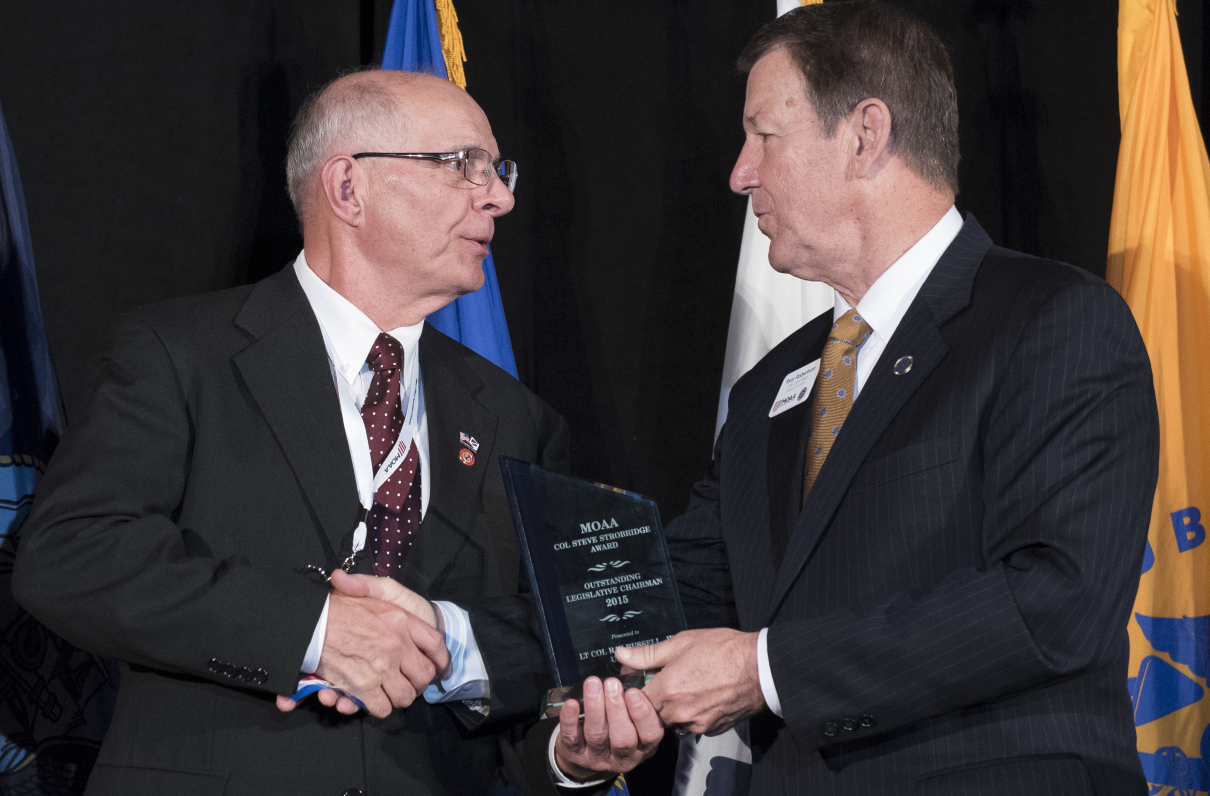(This article by Hope Hodge Seck originally appeared in the April 2024 edition of Military Officer, a magazine available to all MOAA Premium and Life members. Learn more about the magazine here.)
 Each spring, advocates with MOAA head to Capitol Hill to educate lawmakers and their staffs on legislation and policy concerns that affect the military and veterans’ community. Backed by more than 360,000 members from across the uniformed services, MOAA’s voice is powerful and effective: This tradition of advocacy has in the past helped to halt undue TRICARE fee increases; repeal cuts to cost-of-living adjustments for military retirees; and, most recently, pass the Sergeant First Class Heath Robinson Honoring our Promise to Address Comprehensive Toxics (PACT) Act to grant care to millions of veterans affected by toxic exposures.
Each spring, advocates with MOAA head to Capitol Hill to educate lawmakers and their staffs on legislation and policy concerns that affect the military and veterans’ community. Backed by more than 360,000 members from across the uniformed services, MOAA’s voice is powerful and effective: This tradition of advocacy has in the past helped to halt undue TRICARE fee increases; repeal cuts to cost-of-living adjustments for military retirees; and, most recently, pass the Sergeant First Class Heath Robinson Honoring our Promise to Address Comprehensive Toxics (PACT) Act to grant care to millions of veterans affected by toxic exposures.
[LEARN MORE: Advocacy in Action 2024]
This year for the Advocacy in Action event, MOAA has three legislative priorities: passing the much-anticipated Major Richard Star Act; restoring the Basic Allowance for Housing (BAH) to 100%; and preserving the highly valued TRICARE For Life (TFL) program.
Here’s why these issues matter and what MOAA is doing to make a difference.
Restoring BAH
In the nine years since Congress began reducing the military housing allowance from 100% of costs to the current 95%, the average cost of living for military families has only gone up. The monthly cost of groceries is now $969.10 for a family of four, compared with $649.50 in 2015, when the change was made. Likewise, fuels and utilities that cost $20 in 2015 now cost $26.55, an increase of nearly 33%.
[TAKE ACTION: Ask Your Lawmakers to Restore BAH]
Securing available housing after a military move can be higher than ever — and entail an expensive wait in temporary lodgings.
Katie May knows this all too well. She’s moved 17 times in her 21-year marriage to her husband, a Marine Corps lieutenant colonel, and has the war stories to prove it. In 2017, while May was in her final trimester of pregnancy with her sixth of seven children, the family spent 60 days living out of a travel trailer in Warriors’ Path State Park in Tennessee because no apartment rentals were available near her husband’s Reserve unit posting in Jonesboro.
Eventually they were forced to buy a home at a cost above what their housing allowance would cover, but not before the baby came. May recalled laboring in a public park bathroom adjacent to the family’s campsite in an effort not to wake up her children before she was ready to go to the hospital.
When the family moved to Southern California in 2020, they found the cost of living eye-watering, even at a field-grade officer’s pay rate. The family lives on base at Camp Pendleton and saves money by doing haircuts at home and never eating out. She and other officer spouses have even discussed setting up a food pantry on the base.
“I sit with colonels’ wives, and they’re like, ‘If we are buckling down this hard, I have no idea how anybody else is surviving,’” May said.
For May’s family, restoring the BAH to 100% of average local costs would give them another $250 — enough to cover a week’s worth of groceries.
[RELATED: Help MOAA Restore the Basic Allowance for Housing]
These pressures on military families are why MOAA is asking Congress to reverse the BAH reduction, said Cory Titus, MOAA’s director of Government Relations for servicemember compensation and veteran benefits. Only about 30% of servicemembers live on base, he said, and those who live off base often must choose between paying a premium to live close to work or contend with a long commute.
“Either choice is bad,” he said.
Jennifer Goodale, MOAA’s director of Government Relations for military family and survivor policy, added the hidden costs of military moves — those not covered by the dislocation allowance — can exact a heavy toll on families who must relocate every two to three years.
“The amount of unreimbursed PCS costs from replacing things — like food in your pantry and refrigerator, or your cleaning supplies, or all those little things — adds up,” she said.
[MOAA ISSUE PAPER: Restoring BAH]
As the military contends with unprecedented challenges in recruiting an all-volunteer force, Titus and Goodale said, dissatisfaction with military living standards might rob the services of a valuable recruiting tool.
“If there are better stories coming from servicemembers and their families because the military is taking such good care of them, it’s going to reflect when they tell their sons and daughters or their friends’ sons and daughters to join,” Goodale said.
In the past two years, bipartisan measures have been introduced to restore BAH to 100% of housing costs. These measures have yet, however, to make it into the final version of the National Defense Authorization Act (NDAA), the annual bill that sets defense budget policy. In February, a powerful voice joined the chorus for BAH restoration: that of the enlisted leaders of the military services, pushing for the change in testimony before the House Armed Services Committee.
Titus and Goodale said they’d be open to gradual BAH restoration over several years if lawmakers are averse to making the change all at once. BAH reduction was also staggered, ramping down from 2015 to 2019.
“But we really need to make sure that it’s a priority,” Goodale said, “So that the service families know, ‘Hey, we’re being taken care of — they are trying to right the ship.’”
Restoring BAH to 100% would “make a difference,” said Sergeant Major of the Army Michael Weimer at a recent hearing in front of the House Armed Services Committee’s Quality of Life Panel. “It also sends a message … yes, there’s a pocketbook impact, but then there’s a demonstration of caring.”
Passing the Major Richard Star Act
Bill Manofsky was serving the U.S. military well before he ever donned a service uniform. As an engineer for General Dynamics, he helped design the Tomahawk cruise missile and other advanced ordnance before earning a direct commission in the Navy in 1987. Manofsky (call sign “Skyman”) served as a naval flight officer on the P-3 Orion reconnaissance plane and later helped plan highly classified operations, including special operations units’ entry into Iraq in 2003.

Navy Cmdr. Bill Manofsky, shown on deployment in Iraq (left) and recently, faced medical retirement at 17 years of service. He says his pension has been reduced to almost nothing. (Courtesy photos)
But that was all before he sustained a severe reaction to the military-administered malaria drug mefloquine that left his central nervous system damaged and his body afflicted by severe tremors and acute vertigo.
The symptoms forced Manofsky, then a commander, into a medical retirement at 17 years, entitling him to a pension of about $4,010. But for servicemembers with less than 20 years of service, a DoD rule designed to prevent “double dipping” requires that pension to be offset by any disability payment received from the VA. Manofsky’s 100% VA disability rating adds up to about $3,824, all of which is subtracted from his pension check.
The result: His pension from the military for nearly two decades of service is just over $206.
[TAKE ACTION: Ask Your Lawmakers to Help Combat-Injured Veterans]
For Manofsky, this policy isn’t just unfair; it’s also out of step with typical U.S. government practice.
“When a person is disability-retired from the federal government as a civilian, they make you sign up for Social Security, and they only subtract 30% of the Social Security [payment] from your federal retirement,” Manofsky said. “But while all those people … were in the comfort of their home, I was in Kuwait, nearly getting killed by Scud missiles.”
Addressing this inequity is the focus of the Major Richard Star Act, a bill that would end the offset and allow combat-injured veterans who earned a medical retirement — a population of more than 52,000 — to receive both VA disability and their full retired pay. Named for an Army officer who developed combat-related stage 4 lung cancer that was linked to environmental hazards during his deployments to the Middle East and died in 2021, the bill received support from more than two-thirds of Congress, yet did not make it into the FY 2024 NDAA.
A major sticking point is a rule that requires lawmakers to make cuts to government spending elsewhere to cover the added costs of providing these veterans with both earned payments.
For Lt. Col. Mark Belinsky, USA (Ret), MOAA’s director of Government Relations for currently serving and retired affairs, the offset policy is reminiscent of the “widows tax,” a rule that required surviving military spouses to forfeit all or part of the Survivor Benefit Plan annuity they’d purchased when receiving the VA’s Dependency and Indemnity Compensation. That policy was finally repealed in 2023 thanks to a concerted advocacy effort like the one now in support of the Star Act.
“During election years, grassroots advocacy becomes that much more impactful,” Belinsky said. “The voices matter that much more, particularly when we’ve already got two-thirds of the House and Senate signed on.”
The budget problem that is a sticking point for leaders, he said, is likely not as bad as it seems. While the Congressional Budget Office has estimated the bill would cost $9.75 billion by 2033, Belinsky said that figure “seems extraordinarily high” considering the relatively small population of affected veterans and the reality that not all veterans are going to elect to receive concurrent retired and disability pay.
Also, permitting concurrent pays under the Major Richard Star Act would eliminate the Combat-Related Special Compensation (CRSC) that some medically retired veterans receive through their service branch.
“We think it’s likely less than half of the cost,” Belinsky said.
[RELATED: MOAA Answers Your Questions About Concurrent Receipt]

"It's not a bonus of giving me anything," said CWO2 Philip Scheil, USA (Ret), shown on duty (left) and with his grandson, when discussing the Major Richard Star Act. "It's a restoration of previously earned benefits." (Courtesy photos)
For veterans like Philip Scheil, it’s not merely about the money. An Army medevac pilot who was part of the famed Vietnam “Dustoff” crews, Scheil sustained a gunshot wound to the right elbow on a 1969 mission that lacerated his brachial artery and left him with permanent nerve damage and loss of mobility.
His medical retirement pay as a chief warrant officer two is completely offset by his 100% VA disability check, and the CRSC pay he receives represents only a fraction of the pension he’d warrant without the offset. Scheil is active in online groups pushing for the Star Act, using his background as a former U.S. Department of Labor employee to answer questions and offer research. For him, the principle of granting veterans what they’ve worked and fought for is motivation to stay engaged in the push for change.
“It’s not a bonus of giving me anything,” he said. “It’s a restoration of previously earned benefits.”
Protecting TRICARE For Life
Lt. Col. Raymond Russell Jr., USAF (Ret), hung up his uniform in 1990 following a 30-year career, but he has never stopped serving. An active member of MOAA’s New Jersey Lakes and Pines Chapter from the start of his retirement, Russell in 2015 received MOAA’s Colonel Steve Strobridge Legislative Award, recognizing the organization’s best local advocate for legislation supporting military personnel and family members.

Lt. Col. Raymond Russell Jr., USAF (Ret), right, receives MOAA's Colonel Steve Strobridge Legislative Award in recognition of his advocacy efforts. (MOAA file photo)
In 2017, when Russell sought costly proton radiation to treat his prostate cancer, it was time for the nation to make good on its promises to care for him. And it came through — in the form of TFL, health care coverage for those who are eligible for both Medicare and TRICARE.
Through TFL, TRICARE picks up any eligible health care costs not covered by Medicare, and the retiree pays nothing.
With the proton radiation treatment, “I’m cured,” Russell said. “The bill was out of sight, and I never paid a penny except for my travel. So I’m a total believer in TRICARE For Life.”
[RELATED: Ask Your Lawmakers to Protect TRICARE For Life]
TFL is among the most treasured of the military benefits and one MOAA members are most concerned about protecting, said Karen Ruedisueli, MOAA’s director of Government Relations for health affairs.
“It is far and away one of the topics of highest interest to MOAA members,” she said. “And it makes sense — a lot of them are Medicare-eligible and have really come to understand the value of this benefit in their retirement years.”
Because of this, MOAA is taking the unconventional step of making preservation of the benefit a 2024 legislative priority even though there’s not an active threat against it. The mandatory spending associated with TFL makes it a frequent legislative target; as recently as 2022, the Congressional Budget Office (CBO) pushed for new TFL enrollment fees and minimum out-of-pocket costs in an effort to reduce deficit spending. Ruedisueli said it makes sense to educate lawmakers proactively on why TFL represents a promise kept to servicemembers rather than just a perk or entitlement.
[RELATED: TRICARE For Life Under Threat: How MOAA Works to Protect Your Benefit]
Introduced in 2001, six years after the rollout of the TRICARE military health plan, TFL addressed an emerging need: As the military conducted base realignment and closure, fewer military treatment facilities were available to meet the health care needs of eligible veterans.
“People who thought they would be able to count on those facilities for their care suddenly were left with no military health care benefits in their senior years,” Ruedisueli said.
That’s despite the promise made to servicemembers that those who earned an honorable military retirement could count on free lifetime health care. TFL became policy as the global war on terror kicked off, underscoring the dependence of the nation on its all-volunteer force.
“TRICARE For Life … was created to help fulfill this promise of health care for life that had been made to previous generations of servicemembers,” Ruedisueli said. “It was sustained through the 20 years of the post-9/11 wars, so it’s really an essential component of the compensation package.”
With hundreds of thousands of military retirees depending on TFL, MOAA is rolling out an informational and educational campaign around the benefit. Lawmakers, Ruedisueli said, need to understand the history of the benefit as well as the sacrifices servicemembers make across a military career that entitle them to lifelong health care.
With the CBO cost-cutting suggestions currently circulating around Capitol Hill, “it’s really important for us to provide counter-messaging today,” Ruedisueli said, “and not let these concepts gain a foothold before we come in and start explaining why they’re not acceptable.”
Russell said he never stops advocating within his local community of veterans about the benefits and importance of TRICARE For Life. “It’s one heck of a program to honor those who spent a lifetime in the military,” he said.
Hope Hodge Seck is a Washington, D.C.-based writer focusing on military topics.
Military Officer Magazine
Discover more interesting stories in MOAA's award-winning magazine.
